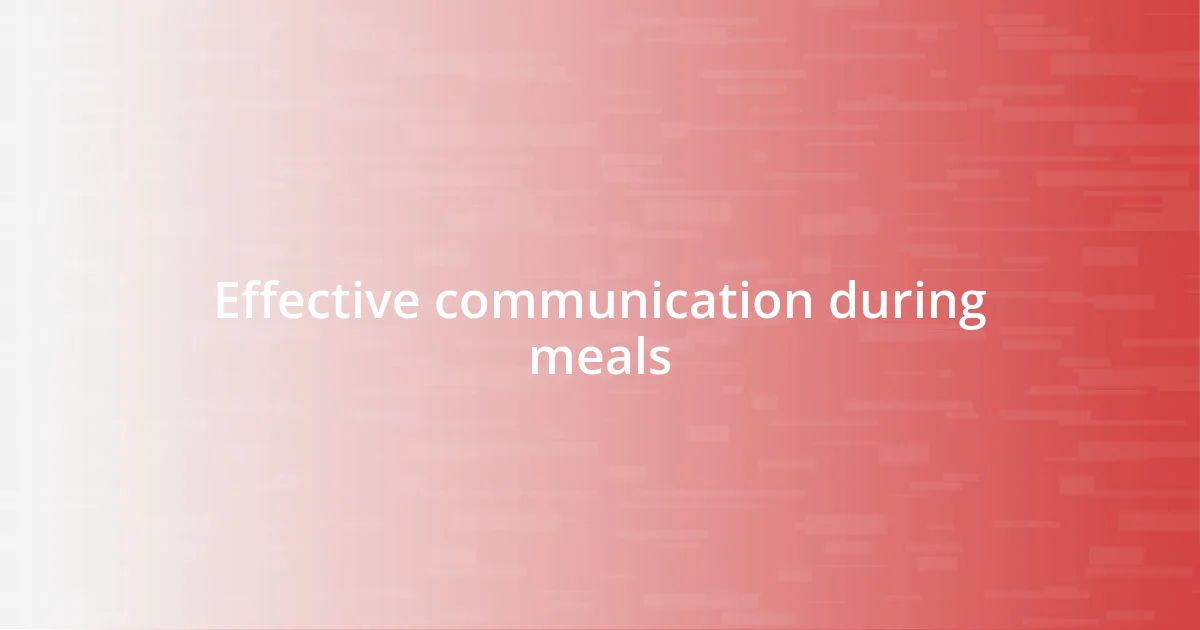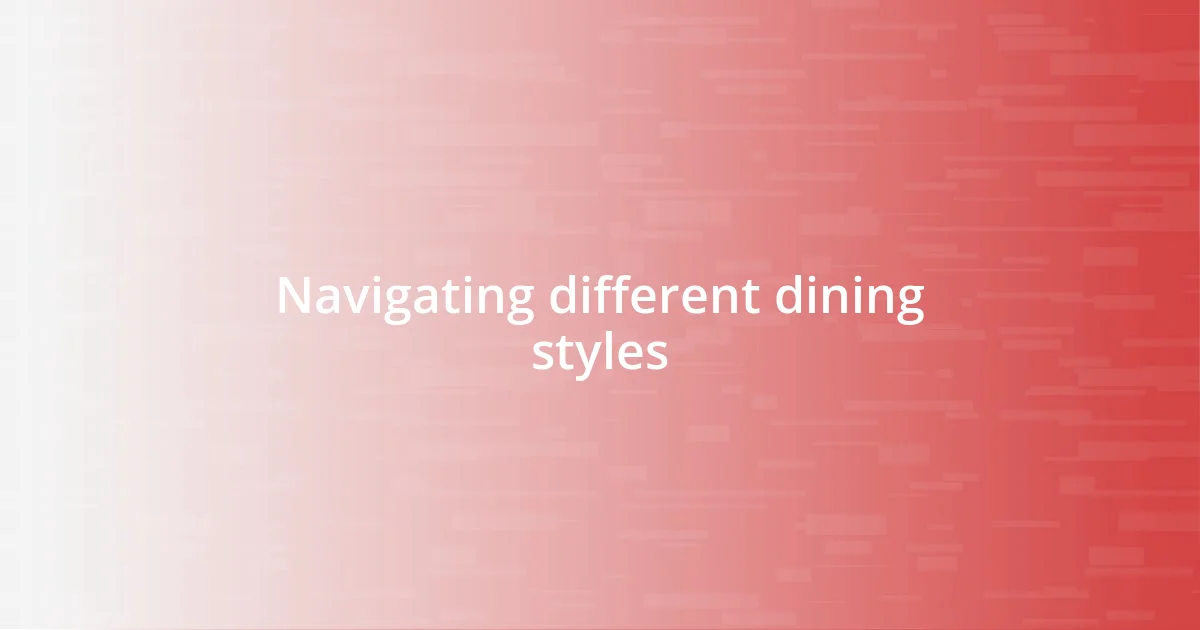Key takeaways:
- Understanding dining etiquette enhances social interactions, reflecting respect for hosts and guests while fostering connections through proper manners.
- Proper table setting and utensil usage are essential for creating an inviting dining experience, making meals more enjoyable and orderly.
- Graceful handling of dining mishaps and genuine communication leave lasting impressions, promoting a warm atmosphere and deepening relationships among diners.

Understanding dining etiquette importance
Understanding dining etiquette is crucial, as it sets the tone for social interactions. I recall attending a formal dinner where every detail, from the placement of utensils to the manner of conversation, dictated the evening’s flow. That experience made me realize how etiquette not only reflects personal upbringing but also respects the host and fellow diners.
I often wonder, what would happen if we ignored these unspoken rules? It can lead to misunderstandings or even awkward moments, and I’ve certainly had my share of them! For instance, I once fumbled with my napkin at a business lunch, and it became a lesson in the importance of being prepared and aware of your surroundings. Mastering dining etiquette creates an atmosphere of comfort and mutual respect, essential in any social setting.
Moreover, etiquette isn’t just about following rules; it’s about connection. On one occasion, I sat next to a stranger at a dinner party, and our shared understanding of proper dining manners opened up a delightful conversation. It struck me how a simple act of politeness can bridge gaps and foster relationships, proving that etiquette is integral to building meaningful connections in our lives.

Basic table setting arrangements
Setting a table properly can transform a meal into a memorable experience. I’ve learned that a well-arranged table not only looks inviting but also offers a sense of order and respect for the occasion. Once, I attended a wedding reception where the table settings were exquisitely arranged, and it heightened my excitement for the evening. The details, from the color of the napkins to the positioning of the silverware, conveyed a warmth that welcomed every guest.
Here’s a quick overview of a basic table setting arrangement:
- Plates: Centrally placed, usually a dinner plate with a salad plate on top.
- Utensils: Positioned in the order of use from the outside in; forks on the left, knives and spoons on the right.
- Glassware: Set above the knife, with the water glass nearest to the plate and wine glasses to the right.
- Napkin: Folded neatly and placed either on the plate or to the left of the forks.
- Centerpiece: A tasteful decoration, like flowers or candles, to add a personal touch without obstructing views.
These simple elements coordinate to create a cohesive aesthetic, which I found adds to the overall dining experience. I recall feeling uplifted at a dinner party where the host’s attention to detail made each guest feel special. It’s amazing how a well-set table can spark joy and anticipation.

Proper utensil usage techniques
Understanding proper utensil usage techniques is essential for navigating any dining situation gracefully. One common point of confusion I’ve observed is how to use utensils during different courses. For instance, I remember attending a formal banquet where the array of utensils overwhelmed me. I quickly learned that the outermost fork is used first and that my knife and fork should always be held in a way that reflects intention. I found it particularly helpful to think of utensils as tools for engaging with my meal, rather than just a means of eating.
In my experience, each utensil has a specific purpose that enhances the dining experience. For example, the salad fork, which is smaller than the dinner fork, is best for lighter fare. I once misused my dessert fork on an entrée and felt so embarrassed! I realized then that understanding these nuances makes meals more enjoyable and less stressful for everyone at the table. It’s not just about eating but about savoring every moment and respecting the setting.
Here’s a quick comparison table to illustrate the correct use of utensils:
| Utensil | Purpose |
|---|---|
| Fork | Main courses and salads |
| Knife | Slicing and cutting food |
| Spoon | Soups and desserts |
| Salad Fork | Smaller salads or appetizers |
| Dessert Fork/Spoon | Sweet courses |
In conclusion, mastering proper utensil usage not only reflects self-assuredness, but it also facilitates smoother dining experiences. Each utensil serves a distinct function, enhancing not only the meal itself but also the enjoyment of the company around you. What has your experience been with utensils? Have you ever faced similar moments of uncertainty?

Effective communication during meals
Engaging in effective communication during meals is just as crucial as the food we eat. At a dinner where I shared stories with friends, I realized the importance of eye contact and active listening. When someone speaks, nodding or responding in an encouraging manner demonstrates that I value their words, creating a warm atmosphere that invites everyone into the conversation.
I’ve also learned that the pacing of conversation can be as important as the topics we discuss. I remember a lively gathering where one person dominated the discussion, leaving others feeling left out. I found solutions by gently redirecting the conversation, asking quieter guests about their thoughts. This not only eased the tension but also made the meal much more enjoyable for everyone involved. How do you make sure everyone gets to share their voice?
In moments of humor, I’ve discovered that laughter truly bonds people at the table. A light-hearted joke can break the ice, helping to ease any awkwardness that might linger. Once, during a formal dinner, I shared an amusing mishap from my cooking adventures, which drew smiles all around and led to shared stories. These relatable moments transform a meal into a shared journey, emphasizing that dining etiquette isn’t just about the rules—it’s about connecting with each other.

Navigating different dining styles
Understanding different dining styles can truly shape your experience, especially in diverse social settings. One memorable evening at a multicultural gala, I found myself in an Indian buffet line, a world away from the sit-down dinners I was accustomed to. The casual approach of scooping food with my hands felt liberating yet daunting at first. However, I quickly learned that embracing this style was about respecting the culture and enjoying the vibrant flavors of each dish.
I’ve also navigated the nuances of formal buffet dining, where the balance between formality and freedom can be tricky. I remember a holiday event where I was unsure whether to sit with my plate or to mingle. It took a moment of observation to see how others gracefully carried their plates and engaged in conversation. This reminded me that dining styles often come with unspoken rules, and adapting to them can lead to more enriching interactions. Have you ever felt torn between different dining styles, unsure of how to act?
Then there are shared plate experiences, which can ignite anxiety about portion sizes. I recall an evening indulging in tapas with close friends, initially hesitant to take the first bite. But as my friends encouraged me to dig in, I discovered the joy of shared meals—not just tasting delicious bites, but also creating a bond over communal food. Each dining style offers its own lessons, reminding me that food is not merely about sustenance, but a vessel for connection and shared memories.

Dealing with dining mishaps gracefully
Sometimes, mishaps happen at the dining table, and how we respond can stick in our memory just as much as the meal itself. I remember a dinner where a fellow guest accidentally knocked over a glass of wine, splattering it across the table. Instead of reacting with embarrassment, they quickly laughed it off, saying, “Well, at least the table is now dressed for the occasion!” This light-hearted approach not only eased the tension but also inspired the rest of us to see the humor in our little blunders.
On another occasion, I found myself struggling with a difficult piece of food, and, in a moment of clumsiness, I sent asparagus flying across the table. Instead of feeling mortified, I chose to apologize with a smile, saying, “Guess my veggies wanted to make a grand exit!” I discovered that admitting to dining accidents with grace can transform a potentially awkward situation into an inclusive moment where everyone feels comfortable and united.
It’s essential to remember that grace amid mishaps isn’t just about managing our mistakes—it’s about setting a tone for the whole meal. I often think about how a simple joke or a kind word can diffuse a potentially awkward scenario, creating a more relaxed atmosphere. Have you ever noticed that a shared laugh can bring everyone back together after a slip-up? It’s these small moments of humanity that turn a meal into a cherished memory, making dining experiences richer and more enjoyable.

Leaving a lasting impression dining
When it comes to leaving a lasting impression while dining, the little touches often speak volumes. I recall a dinner party where a simple gesture made all the difference. I took a moment to compliment the host on her exquisite table setting, expressing how much I appreciated her efforts. It sparked a wonderful conversation about our favorite dining experiences and helped me bond with other guests. Have you ever noticed how genuine compliments tend to open doors to deeper connections?
Another time, I attended a formal dinner where the pause before speaking was palpable. Rather than drowning in the silence, I took a deep breath and shared a light-hearted story about a cooking mishap. The laughter that followed broke the ice, transforming the atmosphere from stiff to warm and inviting. It reminded me that authenticity and vulnerability can leave a powerful mark, don’t you think?
Finally, I learned that a thoughtful farewell can linger in people’s minds. I once ended a dinner by thanking each person individually for their company and shared moments. It felt like a small act, but I could see the smiles spread across their faces. I believe those heartfelt goodbyes resonate beyond the dining table, creating a lasting memory that enriches future encounters. Isn’t it fascinating how a few words can create a ripple effect long after the meal has ended?















